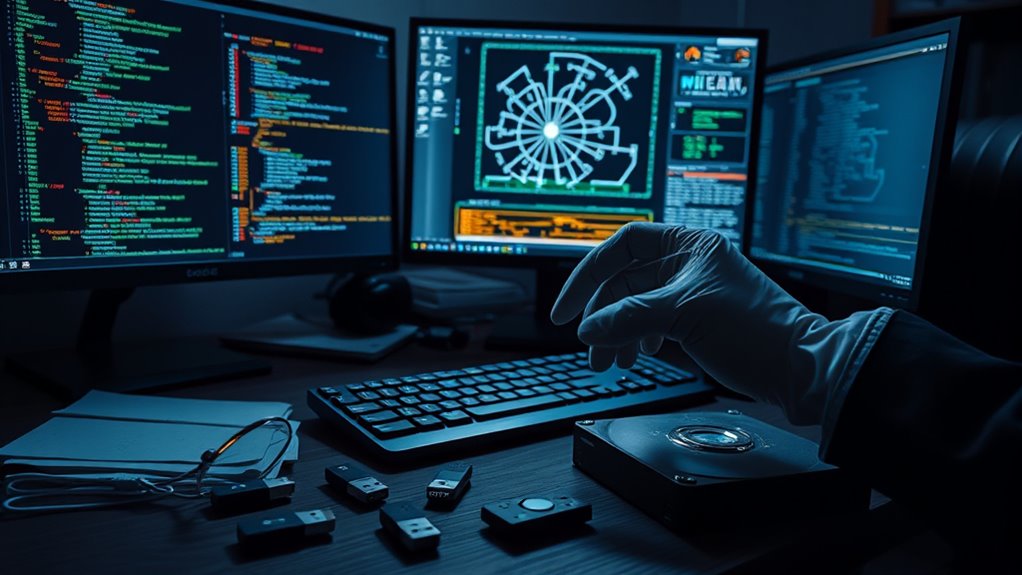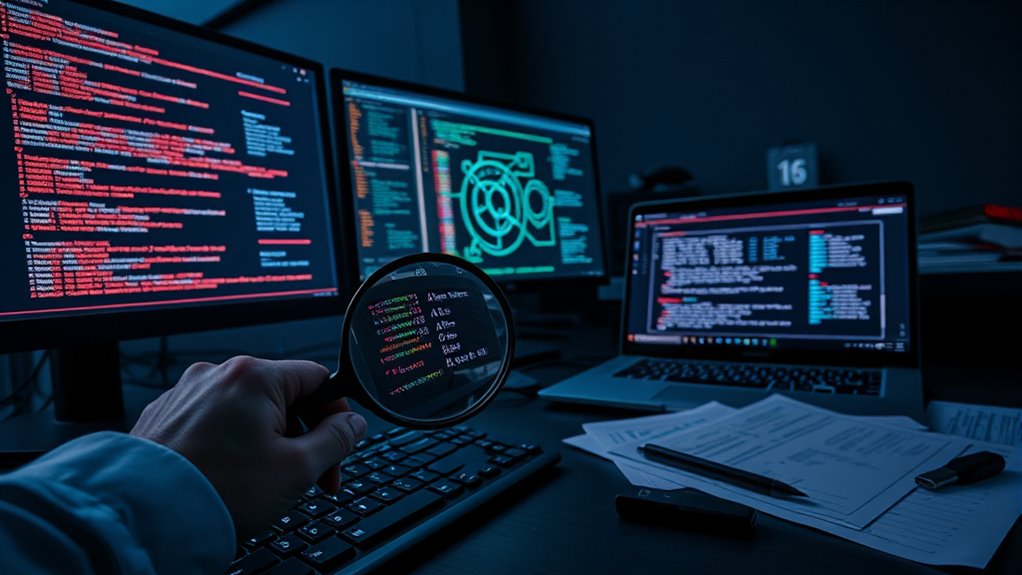To trace an intrusion step by step, first watch for signs like unusual network activity or suspicious account actions. Then, initiate the digital forensic process by identifying relevant devices and preserving evidence with proper chain of custody. Next, extract and analyze data from computers, mobile devices, or servers using specialized tools. Finally, determine how the attacker entered and document your findings carefully. Continuing will help you master the critical steps to effectively respond to security breaches.
Key Takeaways
- Recognize signs of intrusion, such as unusual network traffic or suspicious account activity, to initiate the forensic process promptly.
- Secure and preserve digital evidence through proper collection, hashing, and chain of custody protocols to maintain integrity.
- Use appropriate data extraction techniques—logical, file system, physical, or chip-off—to recover relevant data effectively.
- Analyze evidence systematically, including recovering deleted or hidden files, to identify attack vectors and timelines.
- Document all procedures and findings meticulously to support legal processes and ensure proper attribution of the intrusion.
Recognizing the Signs of a Security Breach

Recognizing the signs of a security breach is crucial for effective incident response. You might notice unusual network traffic patterns, like sudden spikes in inbound or outbound data, which could indicate data theft or intrusion attempts. Traffic from unfamiliar geographic locations suggests external threats, while repeated requests for the same files may be probing or overloading your system. Watch for suspicious DNS requests and unexpected modifications to registry or system files. A sudden increase in database activity or compressed data in strange locations can signal an attack. Additionally, irregular account activity—such as unauthorized administrator actions, failed login attempts, or logins from unusual locations—serves as a red flag. Monitoring network logs regularly is essential to detect these anomalies promptly and prevent further compromise. Recognizing these early warning signs helps you identify breaches early, minimizing damage and guiding your response efforts.
Initiating the Digital Forensics Process

Starting the digital forensics process involves carefully identifying all relevant devices and data sources that might contain evidence. You should list desktops, laptops, servers, smartphones, tablets, and external storage media, making certain none are overlooked. Don’t forget cloud storage and network systems, which may hold vital data. Focus on mobile devices like smartphones and tablets, as they often contain key evidence. Document every device and data source thoroughly, including their locations and functions, to prevent missing critical information. Maintain strict access controls and a clear chain of custody from the start to preserve evidence integrity. Assemble a multidisciplinary team with defined roles, including analysts, cybersecurity experts, and legal advisors, to guarantee a coordinated and compliant investigation from the outset. Proper documentation of each step helps ensure the integrity and admissibility of the evidence collected.
Securing and Preserving Digital Evidence

To properly secure and preserve digital evidence, you need to identify devices and media that may contain relevant data, ensuring they are protected from tampering. You must follow strict chain of custody protocols to document every handling and maintain the integrity of the evidence. Implementing proper data preservation methods, like drive imaging and hashing, helps keep evidence intact and legally defensible throughout the investigation. Establishing and maintaining a clear chain of custody ensures that all evidence remains admissible in court and prevents disputes over its authenticity. Additionally, employing proper data preservation methods, such as drive imaging and hashing, is crucial for maintaining the integrity and authenticity of digital evidence.
Evidence Identification Techniques
Securing and preserving digital evidence begins with accurately identifying all potential sources, including computers, mobile devices, network equipment, and external storage media. You need to locate desktops, laptops, smartphones, tablets, servers, and external drives. Mobile devices often hold critical evidence, so focus on smartphones and tablets. Don’t forget network devices like routers and firewalls, which are key for log analysis. Use specialized tools or techniques to find hidden or encrypted data, such as steganography detection. Proper documentation during this process guarantees nothing gets overlooked. Here’s a quick overview:
| Device Type | Purpose | Key Considerations |
|---|---|---|
| Computers & Laptops | Source of files, logs, and user activity | Forensic imaging required |
| Mobile Devices | Call logs, messages, location data | Focus on smartphones/tablets |
| Network Equipment | Traffic logs, communication traces | Secure collection methods |
| External Storage | Backup drives, USBs, external HDDs | Check for hidden data |
Furthermore, ensuring the integrity of collected evidence is crucial; this involves creating exact forensic copies using bit-for-bit copying techniques to prevent data alteration or loss during analysis. Employing chain of custody procedures helps maintain the evidence’s credibility throughout the investigation process.
Data Preservation Methods
Proper data preservation is essential to maintaining the integrity and authenticity of digital evidence throughout an investigation. You should create a master copy, the original evidence, and a working copy for analysis, ensuring data remains unaltered. Use write blockers during collection to prevent accidental modification, and store master copies in a secure, tamper-proof environment. Verify that copies match the original using hashing algorithms like SHA-256 to confirm integrity. Maintain redundancy by storing copies in multiple locations. Employ digital signatures and encryption to authenticate and protect data. Organize evidence with proper labeling, centralized storage, and version control. Regular backups and secure access controls further safeguard the data, ensuring it remains reliable and admissible in legal proceedings. Implementing proper preservation techniques is crucial for ensuring the evidence’s credibility and usefulness in court.
Chain of Custody Protocols
Understanding the chain of custody is essential for maintaining the integrity and authenticity of digital evidence throughout an investigation. It involves meticulous documentation of each step, from collection to courtroom presentation, ensuring the evidence remains unaltered and credible. To achieve this, you must:
- Carefully control access and handle evidence with secure sealing and storage
- Record every interaction, transfer, and examination with detailed logs
- Use standardized documentation practices to ensure consistency
- Transport evidence securely to prevent tampering or contamination
- Maintaining a complete and unbroken chain of custody is crucial for the evidence to be admissible in court. Following these protocols helps prevent challenges to the evidence’s validity and ensures its admissibility in court. Properly managing the chain of custody safeguards the integrity of your investigation, supports legal processes, and maintains trust in your forensic findings.
Extracting and Analyzing Data From Devices

To extract data effectively, you need to choose the right technique, whether it’s logical, file system, or physical extraction. Once you have the data, analyzing it with forensic tools helps uncover vital evidence like call logs, multimedia, or location data. Understanding these methods guarantees you preserve the integrity of the evidence and gain accurate insights. Proper handling of digital evidence is crucial to prevent contamination or data corruption during the process. Familiarity with home theatre projectors and their features can aid in visualizing how digital evidence may appear on different display types, especially when considering the importance of image quality and calibration during presentations or analysis sessions.
Data Extraction Techniques
Data extraction techniques form the backbone of digital forensics, enabling you to recover and analyze information from various devices. You can choose among several methods based on device condition and investigation goals. For instance:
- Logical Extraction: Quickly retrieves active user data via APIs, but doesn’t access deleted or unallocated space.
- File System Extraction: Captures the file structure and some deleted data stored within databases.
- Physical Extraction: Creates a bit-by-bit image of memory, including hidden, deleted, and system files, offering the most all-encompassing data set.
- Chip-Off Extraction: Removes the flash memory chip physically for direct data retrieval, used when other methods are ineffective.
- Understanding these techniques helps you select the appropriate approach to preserve evidence integrity and maximize data recovery during your investigation, especially when dealing with Glycolic Acid Benefits for Skin and related applications.
Analyzing Digital Evidence
Analyzing digital evidence involves systematically examining collected data to uncover meaningful information that supports an investigation. You start by identifying potential sources like desktops, smartphones, or servers. Preservation guarantees data integrity by isolating and securing evidence to prevent tampering. During examination, you extract relevant data—recover deleted files or detect hidden information using techniques like reverse steganography or cross-drive analysis. Analysis involves interpreting this data to understand user actions, establish intent, or identify suspects. You rely on tools such as FTK Imager, write blockers, and specialized forensic software to facilitate the process. Challenges include dealing with encrypted data, large datasets, and ensuring legal compliance. Effective analysis helps reconstruct user activities, validate claims, and provide clear, technical insights into the intrusion. Advanced forensic tools and techniques are often necessary to handle complex cases involving sophisticated obfuscation or encryption methods.
Identifying the Source and Method of Intrusion

Identifying the source and method of intrusion requires a strategic approach that combines multiple detection and investigative techniques. You start by examining available digital evidence sources, such as desktops, servers, smartphones, and external storage, to gather exhaustive data. Network logs and devices reveal attack vectors, timing, and command-and-control activity. To refine your analysis, consider these methods:
- Use anomaly-based IDS to detect deviations from normal behavior.
- Deploy signature-based IDS for known threat patterns.
- Combine both with a hybrid IDS for broader detection coverage.
- Analyze host-based logs and file integrity to identify compromised systems.
- Employ digital forensics tools and techniques to recover deleted files, trace attacker footprints, and establish timelines of malicious activities. Additionally, understanding common attack patterns can help in attack attribution and preventing future breaches.
Integrating these tools allows you to trace attacker origins and attack pathways efficiently. Proper documentation and preservation of evidence ensure integrity, helping you pinpoint how the intrusion occurred and where it originated.
Documenting Findings and Maintaining Chain of Custody

Accurate documentation of your findings is essential to guarantee the integrity and credibility of your digital forensic investigation. You should record details like seizure location, time, date, and conditions for each piece of evidence. Take photographs of physical devices and screenshots of digital content to establish authenticity and context. Proper labeling of packages and files links physical and electronic evidence, ensuring traceability. Keep detailed logs of administrator actions, file metadata, timestamps, and user access histories to support evidence origin. Maintain a chronological record of all examination steps with screenshots for transparency and reproducibility. Additionally, you must control and document every transfer or handling of evidence to preserve the chain of custody, preventing tampering, and ensuring its admissibility in court. The chain of custody is crucial for demonstrating that evidence has remained unaltered throughout the investigation process. Incorporating proper documentation practices enhances the credibility and reliability of your findings, which is vital in legal proceedings.
Reporting and Supporting Legal Proceedings

Effective reporting is essential to support legal proceedings because it guarantees that digital forensic findings are clear, reliable, and admissible in court. Your reports should be objective, fact-based, and free from bias, ensuring they uphold professional integrity. Include detailed documentation of the methodologies, tools, findings, and any limitations or uncertainties encountered. Clear, concise, and scientifically sound reports strengthen the evidence’s credibility and admissibility. Additionally, communicate findings in a manner that non-technical legal personnel can understand. To enhance the report’s effectiveness, you should:
Clear, objective, and well-documented reports ensure digital evidence is credible and admissible in court.
- Verify all source documentation and maintain a meticulous record
- Clearly outline the scope and limitations of your examination
- Provide expert explanations for technical findings
- Ensure compliance with legal standards and evidentiary requirements
- Adhere to jurisdiction-specific laws governing digital evidence collection to prevent procedural issues
- Maintain chain of custody documentation to preserve evidence integrity throughout the investigation process.
Frequently Asked Questions
How Do Digital Forensics Tools Ensure Evidence Integrity During Analysis?
You guarantee evidence integrity by using forensic tools that create perfect copies of digital media, like FTK Imager or EnCase, and verify them with hash checks. You conduct analysis on these copies, not the original data, and rely on write blockers to prevent any modification. Automated logging and chain of custody tools track every action, maintaining a clear, tamper-proof record that guarantees your evidence remains unaltered throughout the investigation.
What Are Common Challenges Faced When Recovering Deleted Data?
When recovering deleted data, you face several challenges. Encryption can block access if decryption keys are missing, and overwriting files makes recovery impossible. Variations in file systems and secure deletion techniques further complicate the process. On mobile devices and SSDs, data is often unrecoverable due to built-in security features. Additionally, hidden data through steganography or distributed across cloud environments makes locating and restoring deleted information especially difficult.
How Is Legal Admissibility of Digital Evidence Verified?
Think of digital evidence like a delicate sculpture; its legal admissibility depends on careful handling. You must guarantee it meets relevance, authenticity, and integrity standards, akin to preserving the sculpture’s original form. Verify authenticity through metadata, timestamps, and cryptographic hashes, like inspecting fine details. Maintain a strict chain of custody, documenting every movement, to prove unaltered origins. Your adherence to legal and procedural standards makes the evidence court-ready, like presenting a pristine masterpiece.
What Training Is Necessary for Digital Forensics Professionals?
To become proficient in digital forensics, you need specialized training that covers forensic tools, techniques, and legal considerations. Pursue certifications like CCE or GCFA to demonstrate your skills. Gain practical experience through hands-on training and internships, and stay current with industry trends via continuing education. By combining formal education, certifications, and real-world practice, you’ll develop the expertise necessary to analyze digital evidence effectively and ethically.
How Do Investigators Handle Encrypted or Password-Protected Data?
Imagine trying to open a treasure chest with a complex lock—handling encrypted data is similar. You use tools like EnCase, FTK, and Volatility to crack passwords, analyze encryption algorithms, and extract keys from memory. You combine cryptanalysis, side-channel attacks, and memory forensics to find the keys. Preserving volatile memory and collaborating with experts help you access the data, ensuring you don’t miss essential evidence in the process.
Conclusion
As you navigate the delicate dance of digital forensics, remember that each step helps you piece together the puzzle of a breach. With patience and precision, you can uncover hidden truths and gently guide investigations toward resolution. Your careful handling preserves trust and integrity, ensuring that every detail, no matter how subtle, contributes to a clearer understanding. In this quiet pursuit, your efforts become the subtle brushstrokes that bring clarity to complex digital stories.









